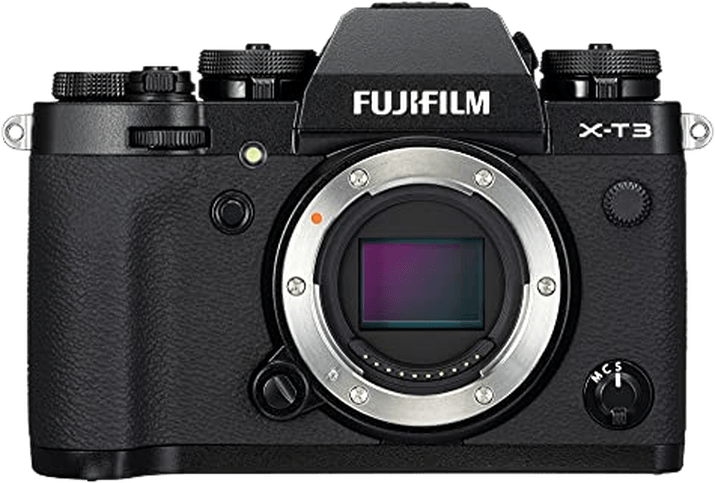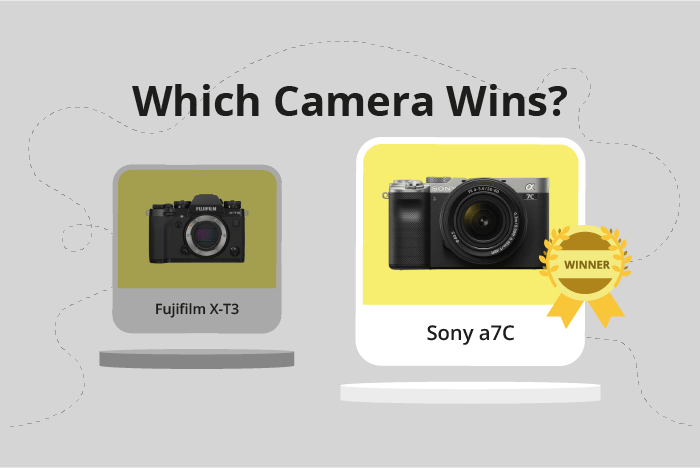Fujifilm X-T3 vs Sony a7C Comparison
Fujifilm X-T3

Sony a7C

The Sony a7C takes the lead with a score of 78/100, outperforming the Fujifilm X-T3, which scored 72/100. Both cameras are mirrorless and share a similar size and weight, with the X-T3 measuring 133 x 93 x 59mm and weighing 539g, while the a7C measures 124 x 71 x 60mm and weighs 509g.
The Sony a7C stands out due to its more recent release date in 2020 and a higher launch price of $1799, suggesting more advanced features and performance. On the other hand, the Fujifilm X-T3, released in 2018, has a lower launch price of $539, making it a more budget-friendly option.
Taking these factors into account, the Sony a7C is the superior camera, offering better performance and functionality. However, the Fujifilm X-T3 is a viable alternative for those seeking a more affordable option without sacrificing too much quality or features.
Fujifilm X-T3 vs Sony a7C Overview and Optics
The Sony a7C takes the lead in our optics comparison, scoring 80/100, while the Fujifilm X-T3 trails behind with a score of 67/100. Both cameras share some common specifications, such as a CMOS sensor type and similar megapixel counts (26 for the X-T3 and 24.2 for the a7C).
The Sony a7C outperforms the Fujifilm X-T3 in several aspects. Its full-frame sensor size offers superior image quality and low-light performance compared to the X-T3’s APS-C sensor. The a7C also has a higher DXOMARK sensor score of 95, indicating better overall image quality. Additionally, the Sony a7C features image stabilization, which reduces camera shake and results in sharper images. The Fujifilm X-T3 lacks this feature.
On the other hand, the Fujifilm X-T3 has a faster shooting speed of 20 frames per second, compared to the Sony a7C’s 10 frames per second. This makes the X-T3 better suited for capturing fast-moving subjects and action photography.
To sum up, the Sony a7C offers superior optics, with a full-frame sensor, higher DXOMARK score, and image stabilization. These features make it a better choice for photographers seeking the best image quality and low-light performance. The Fujifilm X-T3, however, has an advantage in shooting speed, making it a strong contender for action photography. Ultimately, the choice between these two cameras will depend on the specific needs and priorities of the photographer.
Fujifilm X-T3 vs Sony a7C Video Performance
The Fujifilm X-T3 outperforms the Sony a7C in video capabilities, with a score of 83/100 compared to the a7C’s 70/100. Both cameras share some common video specifications, such as 4K max video resolution and built-in time-lapse functionality. However, the X-T3 surpasses the a7C in other aspects, which contributes to its higher score.
The Fujifilm X-T3 boasts a max video dimension of 4096 x 2160, which is higher than the Sony a7C’s 3840 x 2160. Additionally, the X-T3’s max video frame rate is 60fps, double the a7C’s 30fps. These advantages allow the X-T3 to deliver better video quality and smoother motion in footage, making it a more suitable option for videographers who require high-quality results.
The Sony a7C, despite having a lower score, still offers decent video capabilities. Its 4K resolution and built-in time-lapse functionality cater to the needs of casual videographers and photographers who occasionally shoot video. However, the lower max video frame rate and dimensions limit the a7C’s potential for professional-level video work.
Taking these factors into consideration, the Fujifilm X-T3 clearly excels in video capabilities compared to the Sony a7C. The X-T3’s higher max video dimensions and frame rate make it a better choice for professional videographers or enthusiasts seeking top-notch video quality. On the other hand, the Sony a7C remains a viable option for casual users who don’t require the advanced features of the X-T3.
Fujifilm X-T3 vs Sony a7C Features and Benefits
The Fujifilm X-T3 wins the features comparison with a score of 83/100, while the Sony a7C scores 81/100. Both cameras share several specifications, including a 3-inch screen size, touchscreen capabilities, flip screens, and the absence of GPS. Additionally, they both have WIFI and Bluetooth connectivity.
The Fujifilm X-T3 outperforms the Sony a7C in screen resolution, boasting 1,040,000 dots compared to the a7C’s 921,600 dots. This higher resolution provides clearer and more detailed image previews, making it easier for photographers to review their shots and ensure optimal focus and composition.
On the other hand, the Sony a7C does not have any distinct advantages over the Fujifilm X-T3 in the features department. The two-point difference in their scores is solely due to the X-T3’s higher screen resolution.
In terms of features, the Fujifilm X-T3 is the superior camera. Its higher screen resolution offers a more enjoyable and precise image review experience, which can be crucial for photographers when capturing the perfect shot. The Sony a7C, although not better in any specific area, remains a competitive option with similar specifications. Both cameras are reliable choices for photographers, but the Fujifilm X-T3’s advantage in screen resolution gives it the edge in this comparison.
Fujifilm X-T3 vs Sony a7C Storage and Battery
The Fujifilm X-T3 outperforms the Sony a7C in storage and battery, scoring 68/100 compared to the Sony a7C’s 45/100. Both cameras accept SD, SDHC, and SDXC memory cards and offer USB charging. However, the Fujifilm X-T3 provides two memory card slots, doubling the storage potential, while the Sony a7C has only one slot.
In terms of battery life, the Sony a7C excels with 740 shots per charge, significantly outlasting the Fujifilm X-T3’s 390 shots. The Sony a7C uses the NP-FZ100 battery, while the Fujifilm X-T3 relies on the NP-W126S battery. Despite the Sony a7C’s longer battery life, the Fujifilm X-T3’s superior storage capacity and overall higher score make it a more reliable choice for photographers prioritizing storage and battery.
Fujifilm X-T3 vs Sony a7C – Our Verdict
Are you still undecided about which camera is right for you? Have a look at these popular comparisons that feature the Fujifilm X-T3 or the Sony a7C:

